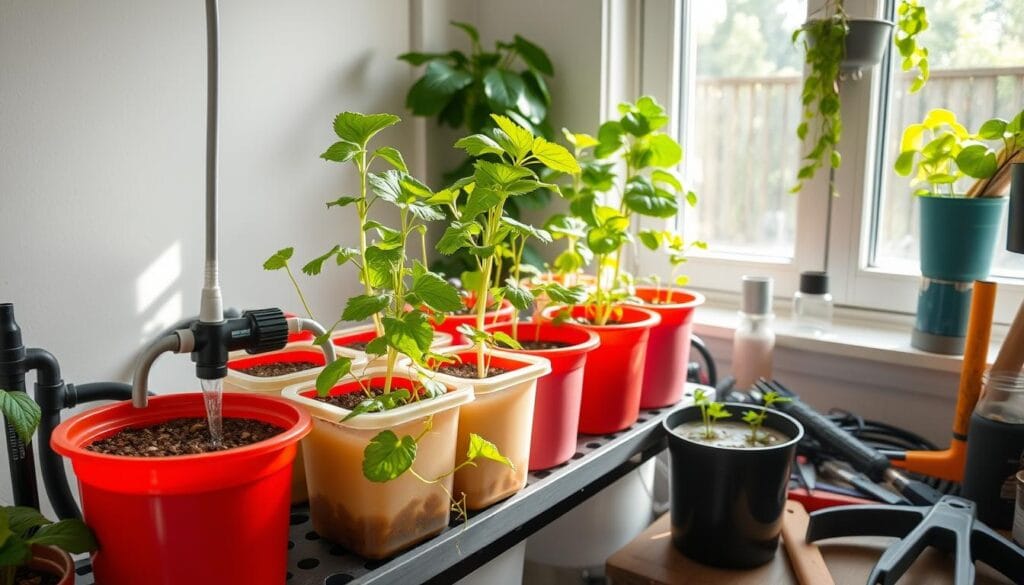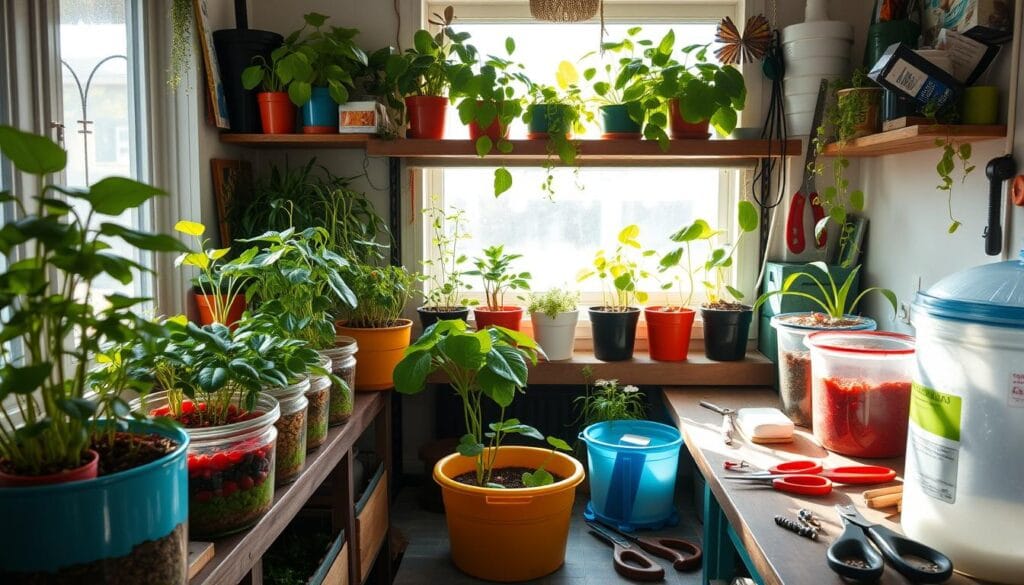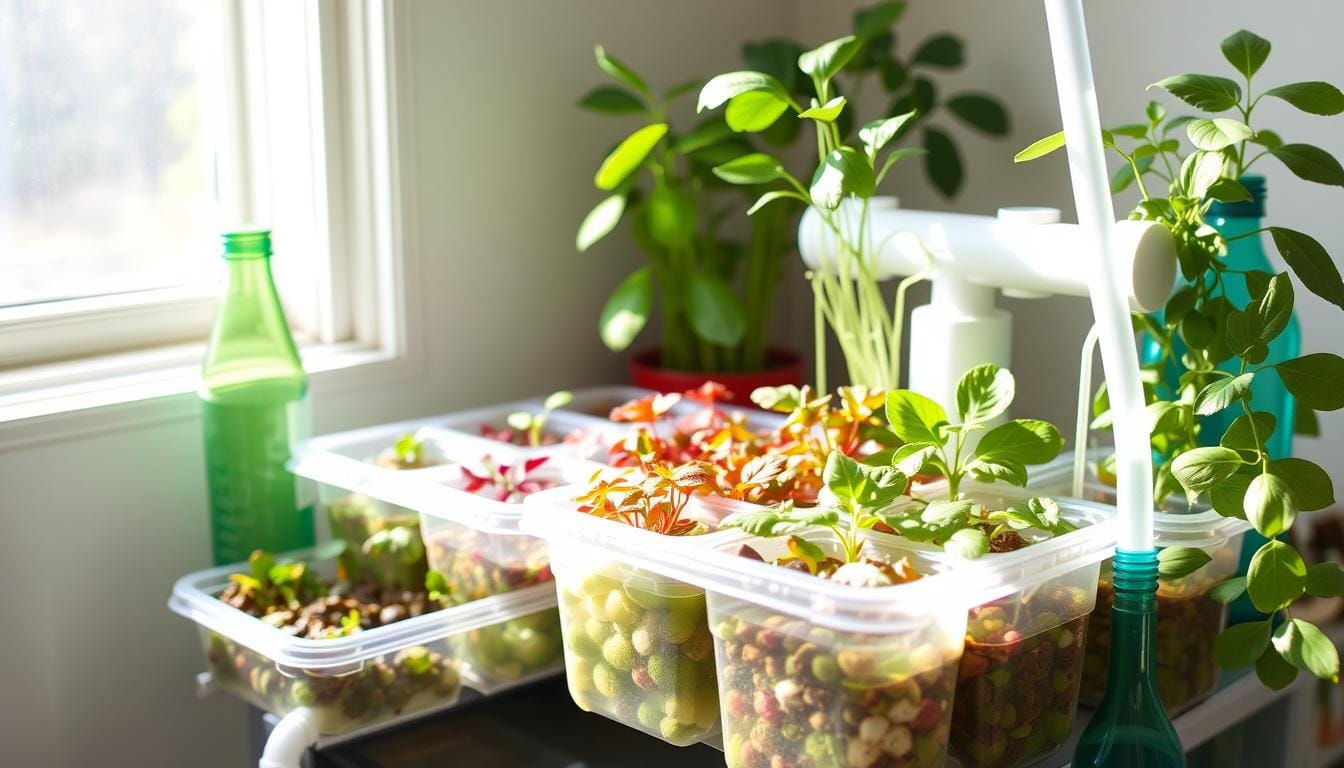Imagine having a lush, thriving garden in your backyard without spending a lot. With diy hydroponics on a budget, you can create a beautiful garden oasis at home. It’s easy to set up and maintain with cost-effective hydroponic systems. Affordable hydroponics is now a reality that can be achieved in just 3 days.
Choosing diy hydroponics on a budget lets you enjoy many benefits. You get higher crop yields, save water, and reduce soil erosion. Cost-effective hydroponic systems let anyone start their garden, regardless of budget or experience. With affordable hydroponics, you can grow your favorite fruits, vegetables, and herbs. You’ll save money and help the environment too.
Key Takeaways
- Create a beautiful garden oasis at home with diy hydroponics on a budget
- Use cost-effective hydroponic systems to save money and reduce environmental impact
- Affordable hydroponics makes it possible for anyone to start their garden
- Enjoy increased crop yields, water conservation, and reduced soil erosion with hydroponic gardening
- Set up your diy hydroponics system in just 3 days
- Grow your favorite fruits, vegetables, and herbs with cost-effective hydroponic systems
Understanding the Basics of DIY Hydroponics on a Budget
Thinking about building your dream garden? It’s key to know the basics of DIY hydroponics on a budget. With inexpensive hydroponic setups and budget-friendly hydroponics projects, you can grow a thriving garden without spending a lot. Low-cost hydroponic gardening is a smart way to start, and with the right info, you can see amazing results.
What is Hydroponics?
Hydroponics means growing plants in a nutrient-rich solution, not soil. This method lets you control growing conditions better, leading to healthier plants. With inexpensive hydroponic setups, you can try hydroponics without spending a lot.
Benefits of Hydroponic Gardening
Hydroponic gardening has many perks, like higher yields, less water use, and healthier plants. Budget-friendly hydroponics projects make it easy to start. With the right help, you can enjoy a rich harvest.
Why Budget-Friendly Systems Work Just as Well
Some might think low-cost hydroponic gardening means lower quality. But, the truth is, affordable systems can be just as good as pricey ones. By picking the right materials and using the right techniques, you can have a thriving hydroponic garden without spending a lot.
Now you know the basics of DIY hydroponics on a budget. You’re set to plan your garden. Keep in mind inexpensive hydroponic setups, budget-friendly hydroponics projects, and low-cost hydroponic gardening options to make your dream garden come true.
Essential Materials and Tools for Your Project
To start with diy hydroponic techniques, you need some basic materials and tools. These will help you build a successful hydroponic garden without spending too much. By choosing hydroponic gardening for less, you can save money while enjoying its benefits.
You’ll need a grow tank, pump, and tubing to begin. Also, get a growing medium like clay pebbles or rockwool, and a nutrient solution. Here’s a list of what you’ll need to get started:
- Grow tank or reservoir
- Pump and tubing
- Growing medium (clay pebbles or Rockwool)
- Nutrient solution
- pH test kit
Using these materials and diy hydroponic techniques, you can make a great hydroponic garden. Always be careful when working with electrical stuff and nutrients. With hydroponic gardening for less, you can enjoy hydroponics without the high cost.
With the right tools and materials, you can grow a healthy hydroponic garden. By using diy hydroponic techniques and hydroponic gardening for less, you can save money and enjoy fresh produce.
Planning Your Hydroponic System Design
Designing your hydroponic system involves several key factors. You aim to make it efficient and affordable. This way, you can save money and grow high-quality crops. First, pick the right system type for your needs.
Popular choices include NFT, ebb and flow, and drip irrigation systems. Each has its pros and cons. It’s vital to research and compare them before deciding. Using recycled materials and optimizing your layout can make your system cost-effective.
Here are some tips for planning your hydroponic system design:
- Select a system that aligns with your available space and budget
- Optimize your system’s layout to minimize waste and reduce energy consumption
- Use recycled materials to create a cost-effective hydroponic system
By following these tips and carefully considering your options, you can build an efficient and affordable hydroponic system. Always look for cost-effective solutions to ensure your garden’s long-term success.
| System Type | Advantages | Disadvantages |
|---|---|---|
| NFT System | Water-efficient, high crop yields | Requires frequent monitoring, can be expensive to set up |
| Ebb and Flow System | Easy to set up, flexible planting options | Can be water-intensive, requires regular maintenance |
| Drip Irrigation System | Water-efficient reduces waste | Can be complex to set up, and requires frequent monitoring |
Cost-Saving Strategies for Hydroponic Components
Building your hydroponic system doesn’t have to be expensive. Look for ways to save money. Using PVC pipes or plastic containers instead of pricey systems is a smart move. It makes your hydroponics project more affordable.
Think about using items you already have at home. An old aquarium or plastic bin can turn into a hydroponic system. This saves money and helps the environment. You can also find cheap supplies at local stores or online. Some good options include:
- Affordable growing media such as coco coir or perlite
- Budget-friendly nutrient solutions
- Energy-efficient LED grow lights
With these strategies, you can build a hydroponics system that’s easy on your wallet. Always choose quality and durability when picking materials and supplies for your projects.
| Material | Cost | Alternative Option |
|---|---|---|
| PVC pipes | $10 | Copper pipes |
| Plastic containers | $5 | Wooden containers |
| Affordable growing media | $20 | Expensive growing media |
Day One: System Assembly and Setup
Starting your diy hydroponics on a budget project is exciting. On day one, you’ll build your hydroponic system. You’ll need to gather materials and tools and follow a guide to set everything up right.
For a cheap hydroponic setup, think about using recycled stuff. An old plastic container can be your reservoir, and a wooden pallet can frame your system. It saves money, cuts down on waste, and is good for the planet.
- Follow the manufacturer’s instructions for any pre-made components
- Use a level to ensure your system is properly aligned
- Double-check all connections to prevent leaks or other issues
By day one, you’ll have a working hydroponic system. It’s ready for the next steps in your project. Stay organized and ask for help if you need it.
Day Two: Installing the Growing Medium and Nutrients
As you move forward with your hydroponic gardening, focus on adding the growing medium and nutrients. This step is key for your plants to grow well. You can use DIY methods to save money.
Choosing the right growing medium is important. Look at options like Rockwool, coco coir, and Perlite. They hold water well and let air in, perfect for saving money.
Selecting Affordable Growing Media
- Rockwool: A favorite for hydroponics, Rockwool is cheap and holds water well.
- Coco coir: Eco-friendly and made from coconut husks, coco coir holds water great.
- Perlite: Light and porous, perlite helps with drainage and air in your system.
By picking the right medium and using DIY methods, you can have a cheap and thriving garden. Don’t forget to mix affordable nutrients and set up water systems.

Mixing Cost-Effective Nutrient Solutions
To make a nutrient-rich mix, combine nitrogen, phosphorus, and potassium. These nutrients help plants grow. With DIY techniques and cheap media, you can enjoy a low-cost garden.
| Nutrient | Function | Recommended Level |
|---|---|---|
| Nitrogen | Promotes leaf growth | 100-200 ppm |
| Phosphorus | Supports root development | 30-60 ppm |
| Potassium | Enhances overall health | 150-300 ppm |
Follow these tips and DIY methods for a thriving, affordable garden. Happy gardening!
Day Three: Plant Selection and Transfer
Today is the last day to set up your hydroponic garden. It’s time to pick and move your plants. Hydroponic gardening for less means choosing plants that do well in these systems. Consider their growth rate, nutrient requirements, and the amount of space they need.
To save money, pick plants that are easy to care for. Leafy greens, herbs, and cherry tomatoes are good choices. Here are some tips:
- Choose plants that are disease-resistant and pest-tolerant to avoid using harmful chemicals.
- Go for plants that need similar things to grow, like the same nutrients and water schedule.
- Use seedlings or clones to start growing sooner.
When moving plants to your hydroponic system, be gentle with their roots. Use hydroponic gardening for less by reusing items like plastic cups for transplanting.
By using these tips and economical hydroponics solutions, you can have a successful hydroponic garden. It will give you fresh, healthy food while saving money. Keep an eye on your plants and adjust your system as needed for the best growth.
| Plant Type | Growth Rate | Nutrient Requirements |
|---|---|---|
| Leafy Greens | Fast | Low |
| Herbs | Medium | Medium |
| Cherry Tomatoes | Slow | High |
Maintaining Your Budget Hydroponic Garden
To keep your budget-friendly hydroponics projects thriving, it’s key to have a routine maintenance schedule. This helps spot and fix issues early, keeping your systems running smoothly and saving money.
Begin by checking the water and nutrient solution daily. Adjust as needed to keep your plants healthy. Also, look for leaks or damage and fix or replace parts quickly.
Daily Maintenance Schedule
- Check water level and nutrient solution
- Inspect the system for leaks or damage
- Monitor temperature and pH levels
Monthly Care Routine
Do a deeper check of your garden every month. Clean the system, check for blockages, and replace any worn-out parts.

By sticking to these maintenance steps, you can keep your hydroponic systems working well. This ensures a good harvest and avoids expensive repairs.
Troubleshooting Common Issues
If you face problems with your garden, don’t worry. Numerous problems can be resolved through basic troubleshooting. For example, if plants aren’t growing, check the nutrient solution and pH levels.
Money-Saving Tips for Long-Term Operation
To keep your hydroponics system affordable, focus on saving money. Start by saving energy. Use LED grow lights and arrange your system wisely to cut down on energy use. This will also lower your electricity bills.
Think about making your hydroponic tools. You can build a water pump or trellis system yourself. This can save you money and be fun.
Managing nutrients is key. Make your nutrient mix with cheap stuff like compost tea or fish emulsion. It’s cheaper and gives your plants what they need. Plus, recycling your nutrient solutions can save money and reduce waste.
Be ready to fix things yourself. Check your system often for damage. Resolving small problems promptly can help you avoid major costs in the future. Use cheap materials like PVC pipes or plastic containers for repairs or upgrades.
Follow these tips to keep your hydroponics system affordable and thriving. Focus on saving energy, managing nutrients, and fixing things yourself. With these steps, you’ll enjoy a great harvest without breaking the bank.
| Money-Saving Tips | Description |
|---|---|
| Energy Conservation | Use LED grow lights and optimize the system layout |
| Nutrient Management | Create your own nutrient solutions using affordable ingredients |
| DIY Equipment Repairs | Regularly inspect the system and address issues promptly |
Scaling Up Your System Without Breaking the Bank
As you get better at hydroponic gardening, you might want to grow more. This could mean more plants or a bigger garden. To do this without spending too much, look for economical hydroponics solutions that fit your budget. You can also reuse materials you already have, which saves money and reduces waste.
Here are some tips for growing your garden:
- Use space-efficient designs to grow more in less space.
- Try low-cost hydroponic gardening by making your nutrient solutions.
- Look for affordable materials and supplies at local nurseries or online.
By following these tips, you can have a bigger hydroponic garden without spending a lot. Always choose economical hydroponics solutions and low-cost hydroponic gardening to keep your garden sustainable in the long run.
Conclusion: Your Journey to Successful Hydroponic Gardening
Congratulations on reaching the end of your DIY hydroponics on a budget journey! You’ve learned the basics, got the right materials, and set up your hydroponic garden. Now, enjoy the endless possibilities of your homegrown, affordable hydroponic oasis.
As you care for your growing hydroponic garden, remember what you’ve learned. Focus on being sustainable, find creative ways to reuse, and keep your system efficient. Stay alert and flexible to get the most from your garden while saving money.
The world of hydroponics is always changing. Don’t hesitate to try new things, learn from your mistakes, and share your knowledge with others. With the right attitude and effort, you can turn your outdoor area into a lush, self-sufficient paradise.
Happy gardening, and may your hydroponic adventures be fruitful and fulfilling!

